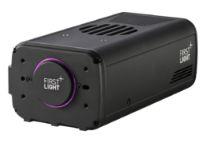Andor NIR SWIR Cameras For Life Sciences Imaging Applications

Andor NIR SWIR Cameras For Life Sciences Imaging Applications
Image thicker and more biologically relevant tissues, organs and even small animal models

Andor’s C-RED camera series features a range of InGaAs based cameras optimised for challenging quantitative scientific measurements within the NIR II/SWIR imaging spectrum. Exceptional sensitivity is matched to high speeds and wide dynamic range over a wide field of view. Superb application flexibility built in to capture both fast and slow processes up to several minutes exposure alike.
C-RED 2 - high speed low noise NIR II/SWIR camera able to run at 600 fps with a very low noise and low dark current
C-RED 2 Lite - compact, temp stabilized format NIR II/SWIR camera
C-RED 2 ER - extended range NIR II/SWIR cameras with sensitivity up to 1.9 µm and 2.2 µm
For further information please contact us or read more on Andor's website.
Small animal studies are vital for studying the developing organism as well as the progression of tumors and other disease states. Imaging using NIR II window enables tissues and organs within these thicker specimens to be imaged without the scattering and absorption encountered using the Vis/UV part of the spectrum.
InGaAs based detectors provide high sensitivity within the NIR II window that is not possible with typical sCMOS and CCD based detectors.
The C-RED series are optimised for imaging dynamic processes within thick specimens such as blood flow, as well as the slower processes such as development of organs or the microstructure within a growing tumor.
 c.elegans and drosophila are valuable models for many neurophysiology studies. However, some questions can only be answered by using larger and more complex models. Conventional UV/Vis range-based imaging is often compromised due to scattering and absorption. By shifting to labels and wavelengths within the NIR II window it solves the issue, but typical detectors do not have much, if any response in this part of the spectrum. Alternate imaging sensor technology such as InGaAs is therefore required.
c.elegans and drosophila are valuable models for many neurophysiology studies. However, some questions can only be answered by using larger and more complex models. Conventional UV/Vis range-based imaging is often compromised due to scattering and absorption. By shifting to labels and wavelengths within the NIR II window it solves the issue, but typical detectors do not have much, if any response in this part of the spectrum. Alternate imaging sensor technology such as InGaAs is therefore required.
With the latest generation InGaAs detectors, C-RED cameras provide high sensitivity across the NIR II window, matched to high-speed capabilities over wide fields of view. C-RED cameras are ideal for many neuroimaging applications- capture the dynamics within neural networks – or observe the intricacies of the nervous system as it develops within a model organism.
 NIR II based imaging permits deeper penetration depths, higher signal-to-background and better spatiotemporal resolution making it of interest to many researchers that are seeking to study thicker tissues, organs and whole animal models.
NIR II based imaging permits deeper penetration depths, higher signal-to-background and better spatiotemporal resolution making it of interest to many researchers that are seeking to study thicker tissues, organs and whole animal models.
New NIR II labels are required with improved binding specificity, brightness and reduced biotoxicity. Another emerging area of interest is the development of single-molecule photosensitizers within the NIR II window that would allow for precise imaged guided destruction of tumours. These and other areas of study require understanding at the small or single molecule scale.
The C-RED camera series are designed for such challenging and quantitative measurements. High sensitivity across the NIR II region is combined with low noise, high-speed and high dynamic range.